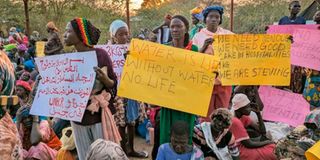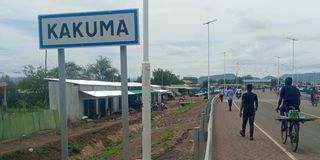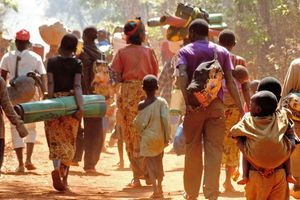
An aerial view of Kakuma 1 Refugee Camp located on the Kenya-Somalia border.
The Kenyan government and humanitarian agencies have unveiled an ambitious plan to transform Kakuma, one of Africa’s most renowned refugee camps, into a functioning city, according to a report by the Associated Press.
More than three decades since its first tents were pitched in 1992, this “windswept and remote camp in the cattle-rustling lands of Kenya’s northwest”, as the report describes it, is now home to some 300,000 refugees. Many of them, “fleeing calamity” in countries such as South Sudan, Ethiopia and the Democratic Republic of Congo, rely on international aid to survive. The nearest city is a lengthy eight-hour drive away.
Although still managed by the United Nations, Kakuma has now been redesignated a municipality, which local government officials are expected to run in the future. This move is part of a broader effort in Kenya—and increasingly in other parts of the world—to integrate refugees more fully into host populations and shift away from prolonged aid dependency. We are told that refugees in Kakuma will eventually be expected to fend for themselves, relying on personal incomes rather than humanitarian assistance.
A 2021 Kenyan law recognises their right to formal employment, but in practice, only a small minority are permitted to do so. Refugees are prohibited from keeping livestock, and farming is virtually impossible due to chronic water scarcity. Many thus turn to entrepreneurship as their only viable path to self-sufficiency.
Small businesses
Even amidst challenges—high start-up costs, limited credit and bureaucratic hurdles—some refugees have succeeded in running small businesses. Indeed, an official who runs a charity providing financial training and low-cost loans to displaced communities in Africa, remarked: “We find that refugee business owners actually have the characteristics that make world-class entrepreneurs.”
Yet sceptics abound. Rahul Oka, an associate research professor at the University of Notre Dame who has studied economic life in Kakuma, has expressed doubts. He argues that Kakuma lacks the resources, particularly water, and the infrastructure to support a self-sustaining economy.

Refugees at Kakuma Refugee Camp and Kalobeyei Integrated Settlement protest over scarcity of food and water on March 3, 2025.
It is precisely these contradictions that make the Kakuma city project so bold. There have been notable successes in refugee resettlement and integration, with Uganda offering perhaps the most progressive model in Africa. In the Oruchinga refugee settlement, established in 1959, residents can own land, participate in local governance and vote in local elections. But no country has yet succeeded in creating a financially independent refugee city.
The idea isn’t entirely without precedent. Jordan’s Zaatari Camp offers a compelling case study. Established in 2012 to host Syrians fleeing civil war, Zaatari has evolved into a semi-permanent, economically vibrant urban settlement. It has long replaced its tents with attractive prefabricated houses.
In the same arid landscape as Kakuma, Zaatari boasts a surprising degree of entrepreneurial activity, especially among young people. Coding boot camps and solar technology start-ups have drawn international attention. A $10 million solar power plant, opened in 2017, has reduced energy costs while generating green jobs. The camp is now home to around 80,000 residents and more than 3,000 small businesses.
Nonetheless, aid dependency remains high in Zaatari, especially for essential needs such as food, shelter, and healthcare. And the residents’ freedoms are severely restricted. The camp is fenced and tightly guarded by Jordanian security forces.
Kenya has an opportunity to do better: to offer greater freedom while still retaining a degree of control. In fact, rather than building just one refugee city in Kakuma, it could aim for two. Why not relocate some refugee groups—Ethiopians, Somalis and South Sudanese—to an island in the Indian Ocean, and others—Congolese and Central Africans—to one in Lake Victoria?
Pressing problem
This would immediately solve Kakuma’s most pressing problem: lack of water. It would also open the door to large-scale agriculture. Islands offer natural fishing grounds and provide raw materials for brick-and-mortar construction. The main investment would be ferry infrastructure. Beyond that, one could simply provide the refugees with basic tools, seeds, essential household items, and solar panels—all on credit. Return a year later and you might find a flourishing micro-city, ready to repay you with interest.

A sign post of Kakuma town where Kakuma Refugee Camp and Kalobeyei Integrated Settlement are located.
There’s also a politically strategic upside. In a country like Kenya, where ethnic politics can be deeply polarising, refugees might serve an unexpected function. Historically rival communities may temporarily set aside their differences to unite against the perceived success of outsiders. If the refugees are living on a prosperous island, they would have time to jump on boats and make their escape before approaching angry locals set upon them, thus avoiding a nasty international incident.
Admittedly, this plan would provoke some controversy. But the current model—warehousing human potential in endless dependency—is neither sustainable nor humane. It’s time to think differently. I stand with the Kenyan government on this one.
The author is a journalist, writer and curator of the "Wall of Great Africans". Twitter@cobbo3.

